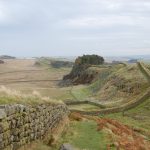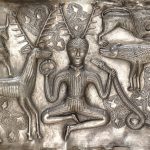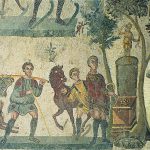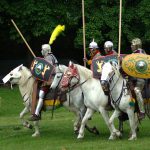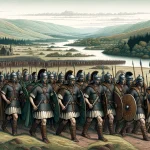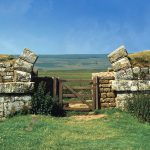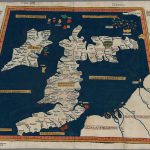Portus Setantiorum (?)
Probable Port
Portus Setantiorum – The Seaport of the Setantii
The only classical geographical treatise that deals with Britain’s north-west coast is Geography of Ptolemy which was published in the latter half of the second century. In his work Claudius Ptolemaius describes the ancient British coastline, naming (in the order they are listed): Moricambe Aestuarium (Morcambe Bay), the mysterious entry Portus Setantiorum, then the rivers Belisama and Seteia, the latter two streams have been identified with the River Ribble in Lancashire and the River Mersey in Merseyside, respectively.
Another clue which suggests that a Roman settlement was once located at the northern end of the Fylde is, however, pretty substantial. There is a known Roman road which runs from the important fort and settlement at Ribchester westwards towards the coast, which unaccountably makes a sharp, sixty-degree turn to the north about three miles beyond the fort at Kirkham, and heads almost directly towards Fleetwood. Evidence for this road disappears beneath Foulton-le-Fylde and Thornton, but it is fairly certain that the road continued to the northern end of the Fylde. Now, the Romans were not in the habit of building roads that led nowhere, so it must be expected that this one had a northern terminus.
Portus Setantiorum, mentioned by Ptolemy, has never been positively identified, but it is thought to have been located on the Fylde near the mouth of the River Wyre near to the modern fishing town of Fleetwood in Lancashire. Very few Roman artifacts have been recovered from Fleetwood, and there are no inscriptions on stone recorded in the R.I.B. for the town, indeed, the whole area of the Fylde has so far yielded very few indications of settlement during the Romano-British period.
There are three possible explanations for this lack of corroborative archaeology:
- Portus Setantiorum lies buried beneath the modern town of Fleetwood, waiting to be discovered.
- The ancient port does not lie at Fleetwood at all, but elsewhere.
- Ptolemy’s seaport lay to the north of the modern town and has since been lost to the sea.
Of these, the first is the least likely, as the town is very modern, being named after Sir Peter Fleetwood, who laid out the street-plan as recently as 1836; if there were any substantial Roman buildings in the area, surely they would have been recorded during the town’s construction. The second option is also quite unlikely, given the supporting geographical evidence of Ptolemy and the otherwise dysfunctional Roman road. Besides, there are no real alternatives; Blackpool and Lytham St. Anne’s nearby on the western coast of the Fylde are both far too exposed, and the modern town of Morecambe near Lancaster, which until 1870 was known as Poulton-le-Sands, is a modern revival of the original name (Welsh/Gaelic) for the River Lune recorded in Ptolemy, Morikambe means ‘the curved inlet’.
The only possible explanation must be that Portus Setantiorum was built somewhat to the north of the modern town of Fleetwood, probably in the area of North Wharf, and has since succumbed to the eroding effects of the Irish Sea, the general rise in sea-level since the Roman period, and the nature of the River Wyre itself, upon the western bank of which the ancient seaport probably once stood, which is prone to flooding every winter/spring. (For a discussion of the problem see Richmond pp.52/3.)
Who Were The Setantii?
The entry in Ptolemy’s Geography is easily translated as ‘the Seaport of the Setantii (tribe)’, and this remains the only reference we have of their existence. The Setantii apparently occupied the area of central Lancashire and the Fylde and were a small sept or sub-tribe of the powerful Brigantes Brigantes[/link_post], who ruled the entire north of England during the Romano-British period. The Brigantes were an agglomeration of many smaller tribes who came under the dominion of a tribal overlord, perhaps based somewhere on the Yorkshire moors, as their civitas capital during the Roman administration was at Isurium Brigantum (Aldborough, North Yorkshire). The larger septs of this tribe included the Parisi of North Humberside and the Carvetii of Cumbria, while other, smaller septs are known or hinted at, such as the Corionototae from the area around Corstopitum (Corbridge, Northumberland; vide RIB 1142).
References for Portvs Setantiorvm
- Historical Map and Guide – Roman Britain by the Ordnance Survey (3rd, 4th & 5th eds., 1956, 1994 & 2001);
- Recent Discoveries in Roman Britain From the Air and In the Field by I.A. Richmond in J.R.S. XXXIII (1943) pp.45-54;
Roman Roads near Portvs Setantiorvm
SSE (14) to Kirkham (Lancashire)
Sites near Portus Setantiorum (?)
- Hen Ffordd -The Old Road (0)
Roman Road - Woodhead Camp (0)
Marching or Temporary Camp - Whittlebury Villa (0)
Villa - Wighton (0)
Possible Roman Camp - Willowford Temporary Camp (0)
Marching or Temporary Camp - Bury Hill (0)
Iron Age Hillfort and Settlement - Warham Camp (0)
Iron Age Hillfort - Water Eaton (Kinvaston) 1 Temporary Camp (0)
Marching or Temporary Camp - Wath (0)
Marching or Temporary Camp - Wall Marching Camp 1 (0)
Marching or Temporary Camp
